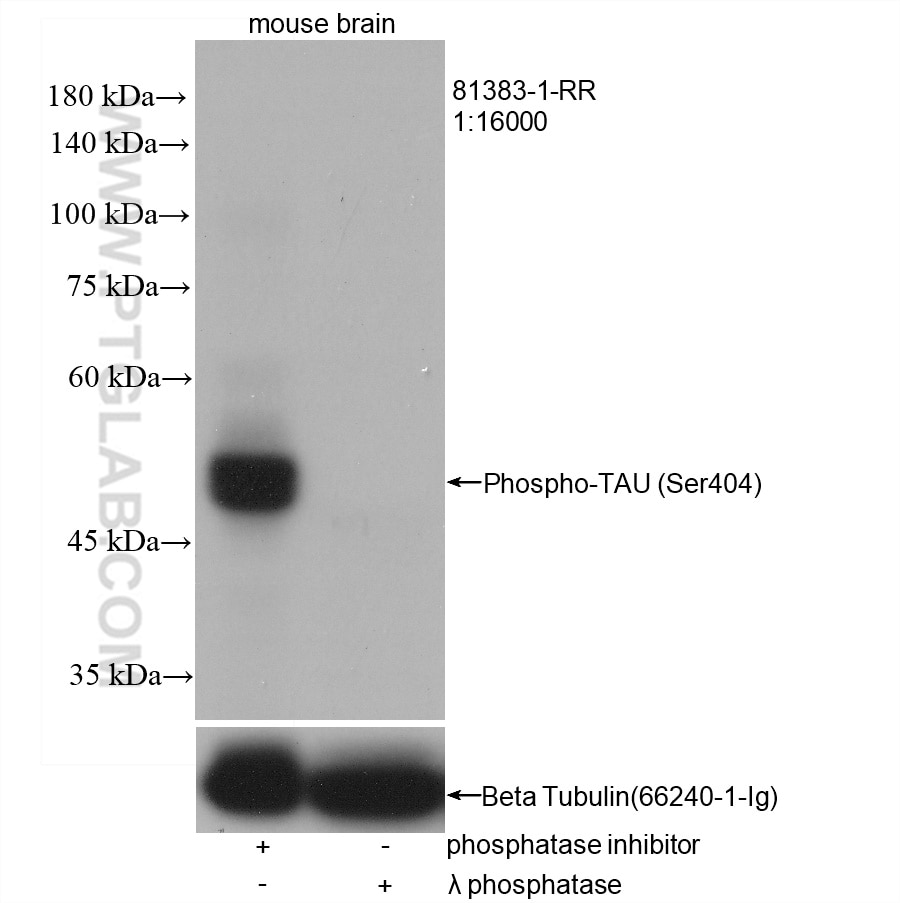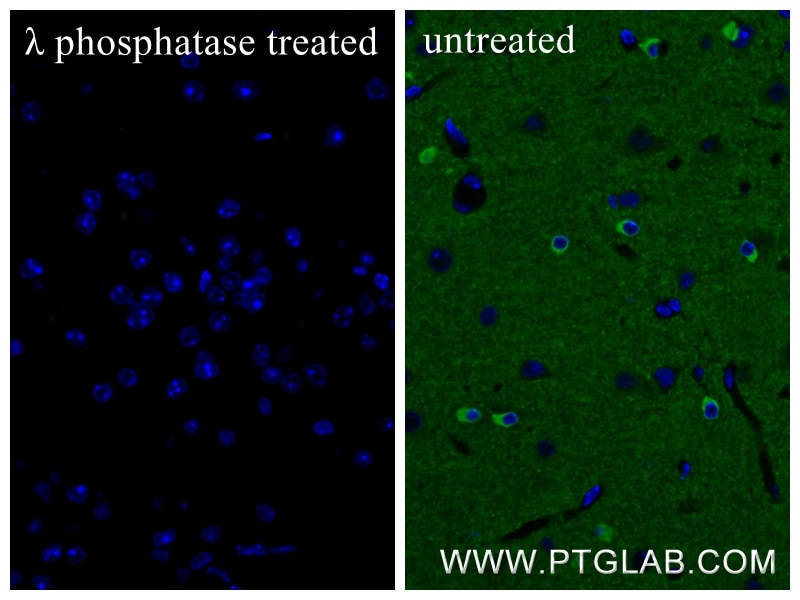Validation Data Gallery
Tested Applications
| Positive WB detected in | mouse brain tissue |
| Positive IF-P detected in | mouse brain tissue |
Recommended dilution
| Application | Dilution |
|---|---|
| Western Blot (WB) | WB : 1:5000-1:50000 |
| Immunofluorescence (IF)-P | IF-P : 1:200-1:800 |
| It is recommended that this reagent should be titrated in each testing system to obtain optimal results. | |
| Sample-dependent, Check data in validation data gallery. | |
Published Applications
| WB | See 5 publications below |
| IF | See 2 publications below |
Product Information
81383-1-RR targets Phospho-TAU (Ser404) in WB, IF-P, ELISA applications and shows reactivity with human, mouse samples.
| Tested Reactivity | human, mouse |
| Cited Reactivity | human, mouse |
| Host / Isotype | Rabbit / IgG |
| Class | Recombinant |
| Type | Antibody |
| Immunogen |
Peptide 相同性解析による交差性が予測される生物種 |
| Full Name | microtubule-associated protein tau |
| Calculated molecular weight | 37-46, 79-81 kDa |
| Observed molecular weight | 45-55 kDa |
| GenBank accession number | BC000558 |
| Gene Symbol | TAU |
| Gene ID (NCBI) | 4137 |
| RRID | AB_2935426 |
| Conjugate | Unconjugated |
| Form | |
| Form | Liquid |
| Purification Method | Protein A purification |
| UNIPROT ID | P10636 |
| Storage Buffer | PBS with 0.02% sodium azide and 50% glycerol{{ptg:BufferTemp}}7.3 |
| Storage Conditions | Store at -20°C. Stable for one year after shipment. Aliquoting is unnecessary for -20oC storage. |
Background Information
Tau (tubulin-associated unit) is a microtubule-associated protein (also known as MAPT), expressed mainly in neurons of the central nervous system. Its primary function is to modulate microtubule dynamics for maintaining axonal cytoskeleton. The Tau protein has six isoforms produced from a single gene through alternative RNA splicing. Isoforms differ in number of inserts at the N-terminal half and the number of repeats at the C-terminal half (3 repeat-3R; 4 repeat-4R). Tau is hyperphosphorylated during aging and in age-related neurodegenerative diseases such as Alzheimer's disease (AD) and fronto-temporal dementia. Hyperphosphorylation of Tau leads to the formation of neurofibrillary tangles (NFT) in the neurons and glia cells, which is one of the hallmarks of AD.
Protocols
| Product Specific Protocols | |
|---|---|
| WB protocol for Phospho-TAU (Ser404) antibody 81383-1-RR | Download protocol |
| Standard Protocols | |
|---|---|
| Click here to view our Standard Protocols |
Publications
| Species | Application | Title |
|---|---|---|
Neuromolecular Med Lycium Barbarum Polysaccharides Improves Cognitive Functions in ICV-STZ-Induced Alzheimer's Disease Mice Model by Improving the Synaptic Structural Plasticity and Regulating IRS1/PI3K/AKT Signaling Pathway | ||
Foods Comparative Analysis of Egg Yolk Phospholipid Unsaturation and Its Impact on Neural Health in Alzheimer Disease Mice | ||
J Med Chem Discovery of Effective Dual PROTAC Degraders for Neurodegenerative Disease-Associated Aggregates | ||
Redox Biol Absence of astrocytic ceruloplasmin reverses the senescence process with aging of learning and memory abilities | ||
Neurochem Int Suppression of KDM5C mitigates the symptoms of Alzheimer's disease by up-regulating BDNF expression |


